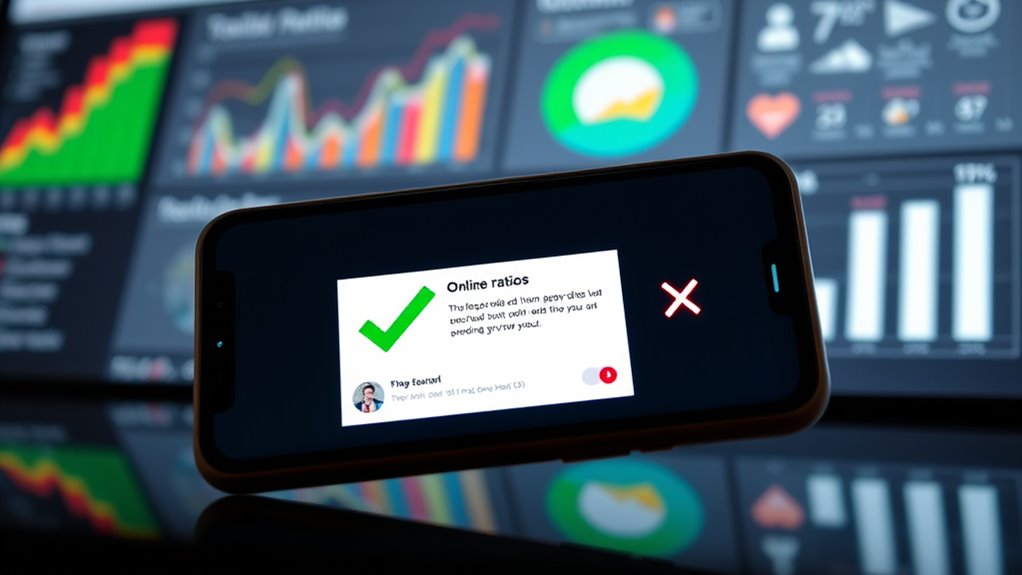When someone asks what a “ratio” means online, it refers to how audiences react to your content by comparing engagement metrics like likes, replies, or quote tweets to your follower count or views. A high ratio might indicate controversy or strong engagement, while a low one suggests the post isn’t resonating. Understanding these signs helps you gauge your content’s impact and whether to adjust your approach—if you want more details, keep exploring.
Key Takeaways
- “Ratio” refers to comparing engagement metrics like likes, replies, or retweets to measure a post’s popularity or controversy.
- A high ratio of replies to likes often indicates disagreement or debate around the content.
- “Getting ratioed” means a post has more replies or quote tweets than likes or retweets, signaling disapproval.
- Ratios help assess how well content resonates with audiences and its overall impact or virality.
- Understanding ratios involves analyzing platform norms and context to interpret whether engagement reflects approval or controversy.
The Origin of the Term in Digital Spaces
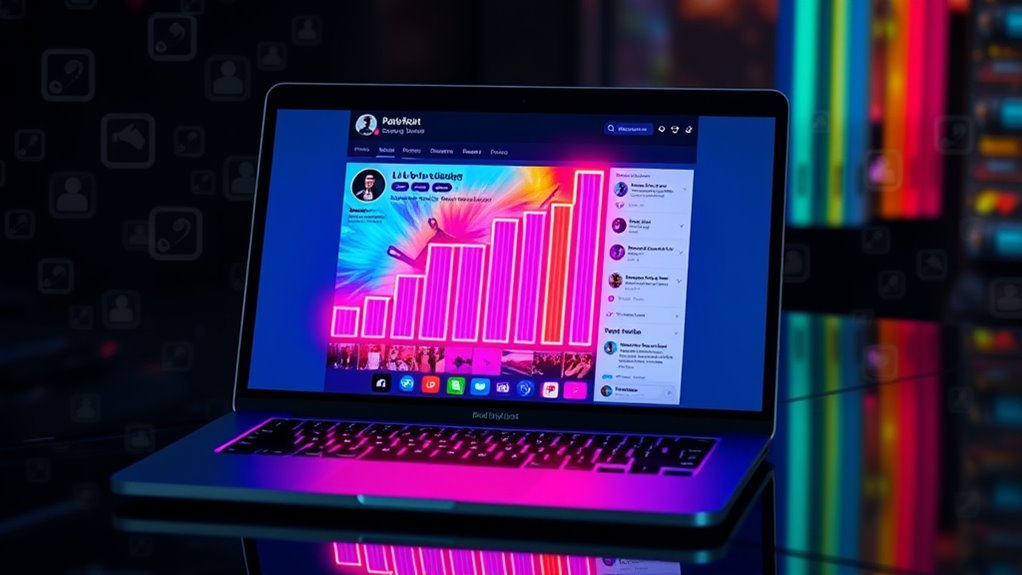
Have you ever wondered where the term “ratio” first appeared in online conversations? It originates from digital slang used on social media platforms like Twitter and Reddit. Early on, users started referencing ratios as a way to measure the success or failure of a post based on online metrics. When a tweet or comment received more replies or quote tweets than likes or retweets, people said it was “getting ratioed,” indicating it was unpopular or controversial. This informal shorthand quickly caught on, becoming a way to assess how well content resonated with the audience. Over time, “ratio” evolved from a simple reaction to a key part of online metrics and digital slang, symbolizing social approval or disapproval in digital spaces. Understanding narcissism can help explain some of the behaviors behind online interactions and reactions.
Understanding the Components of a Ratio

Do you know what elements make up a typical online ratio? It’s essential to understand the component breakdown for effective ratio analysis. Usually, a ratio compares two numbers, like likes to followers or comments to views. These components reveal how people engage with content relative to its reach. The numerator shows the level of engagement, while the denominator indicates exposure or audience size. By analyzing these parts, you can assess whether your content resonates or needs improvement. Recognizing the components helps you interpret ratios more accurately and compare different posts or platforms. This understanding clarifies what the ratio indicates about public reception and overall engagement. Additionally, understanding the types of ratios used in online metrics can provide deeper insights into content performance. Ultimately, a clear component breakdown makes your ratio analysis more meaningful and actionable.
How Ratios Indicate Public Reception

Ever wonder what a high or low ratio says about how your content is received? Ratios can reveal whether your post resonates or falls flat. A high ratio, like many replies compared to likes, often indicates controversy or strong engagement, especially in viral trends or meme culture. Conversely, a low ratio suggests your content might be overlooked or misunderstood. To interpret ratios better:
High reply-to-like ratios signal controversy; low ratios suggest passive approval or overlooked content.
- A high reply-to-like ratio signals debate or disagreement.
- A low reply count with many likes hints at passive approval.
- Rapid shifts in ratios can reflect trending topics or meme cycles.
- Understanding the caffeine content in related topics can influence audience interest or skepticism.
Understanding these signals helps you gauge public reception accurately. Ratios don’t just measure popularity—they reveal audience sentiment, engagement depth, and how content fits into viral trends or meme culture.
Differences Between Likes, Retweets, and Replies

Understanding the different types of engagement on social media can help you interpret public reception more accurately. Likes show appreciation or agreement, often boosting content’s visibility through social algorithms. Retweets, on the other hand, help content spread widely, making it a key factor in viral trends. Replies indicate direct interaction and can spark conversations, offering insight into how people engage beyond surface-level approval. Each metric serves a different purpose in shaping online conversations and content reach. Likes can signal popularity, retweets expand reach, and replies reveal community engagement. Recognizing these differences helps you understand why some posts go viral and how social algorithms prioritize content, guiding your strategies for meaningful online interaction. Additionally, understanding content types can improve your ability to analyze online engagement effectively.
What a High Ratio Signifies

A high ratio often signals strong engagement from your audience, showing they’re actively responding to your content. It also indicates your posts hold significant popularity and influence within your community. Recognizing this can help you understand how your online presence resonates with others. Additionally, analyzing audience response patterns can provide insights into effective content strategies.
Engagement Level Indicator
Have you ever noticed a high ratio on a social media post and wondered what it means? A high ratio often indicates strong engagement, revealing how the audience interacts with content. It’s a key social metric used to gauge a post’s impact.
- It suggests your content resonates, potentially sparking viral trends.
- It signals that people are commenting, sharing, or reacting more than just liking, showing deeper involvement.
- It often attracts more visibility, boosting your profile’s influence.
- The significance of a high ratio is reinforced by the engagement level indicator, which helps interpret audience response more accurately.
A high ratio isn’t just about numbers; it reflects the relevance and emotional connection your content fosters. When you see a high ratio, it means your post’s engagement level is elevated, highlighting its significance within the broader social metrics landscape.
Popularity and Influence
When a social media post achieves a high ratio, it often signals that the content has gained significant popularity and influence. A high ratio suggests your post has resonated with a large audience, sparking viral trends and shaping meme culture. People are engaging more with your content, sharing it widely, and commenting, which amplifies its reach. This kind of influence can elevate your profile, making you a trendsetter or key voice within online communities. It also indicates that your message or humor struck a chord, prompting others to imitate or discuss it. Ultimately, a high ratio reflects not just popularity but the ability to sway opinions, set trends, and become part of the viral cycle that defines internet culture today. Additionally, understanding the impact of AI-driven content can help creators strategize for more meaningful engagement.
Common Reasons for Negative Ratios

Negative ratios often occur because of mismatched expectations or misinterpretations of online interactions. When you jump into viral trends or meme culture without understanding the context, your responses might be misunderstood, leading to unfavorable ratios. Here are some common reasons:
- Misaligned tone: Humor or sarcasm may be taken seriously, causing negative reactions.
- Overhyped content: Participating in trending topics without authenticity can backfire.
- Misinformation spread: Sharing viral memes or trends without fact-checking can lead to backlash.
- Lack of context: Failing to consider the online community norms and culture can also contribute to negative ratios.
These issues highlight how online engagement is delicate. When your responses don’t match the community’s vibe or are misunderstood, negative ratios follow. Recognizing these pitfalls helps you navigate digital spaces more effectively.
The Impact of Ratios on Online Reputation
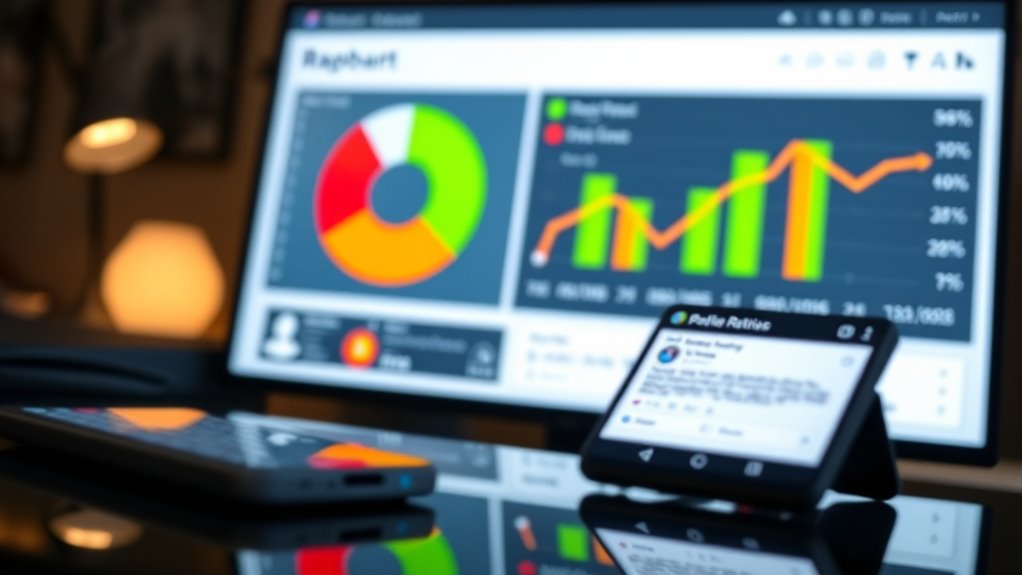
Ratios on social media can considerably influence your online reputation, shaping how others perceive you. When your ratio reflects positive engagement, it often signals credibility and trustworthiness. Viral trends can amplify this effect, making your content more visible and influencing public perception. Conversely, negative ratios or inconsistent engagement might raise red flags, prompting others to question your authenticity. Sentiment analysis helps gauge the overall tone of comments and reactions, offering insight into how your audience feels about you. A strong positive ratio combined with favorable sentiment can boost your reputation, attracting more followers and opportunities. Maintaining a healthy ratio is key to managing your digital reputation effectively. Additionally, understanding the impact of engagement metrics can help you tailor your content strategy for better online standing.
How to Interpret Ratios in Different Contexts
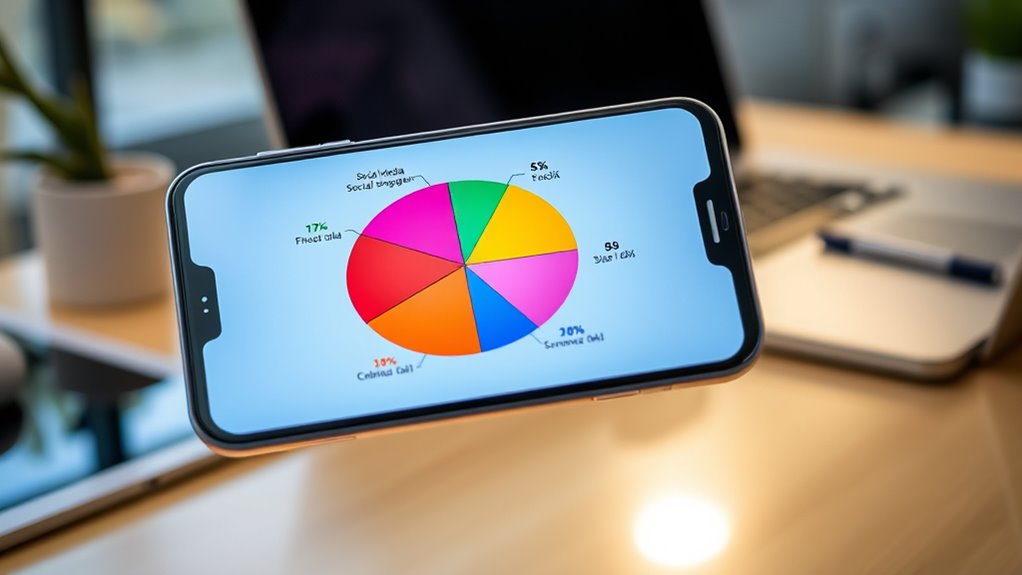
Interpreting ratios correctly requires understanding the context in which they appear. For example, a high ratio in social media comments might indicate strong engagement, but if it’s linked to viral trends, it could also signal controversy. To grasp their deeper meaning, consider these points:
- Recognize whether the ratio reflects positive or negative sentiment, which depends on the context.
- Use digital literacy to differentiate between ratios driven by genuine interest and those influenced by manipulation or viral trends.
- Remember that ratios can vary across platforms; what’s significant on one might not be on another.
The Role of Ratios in Digital Discourse
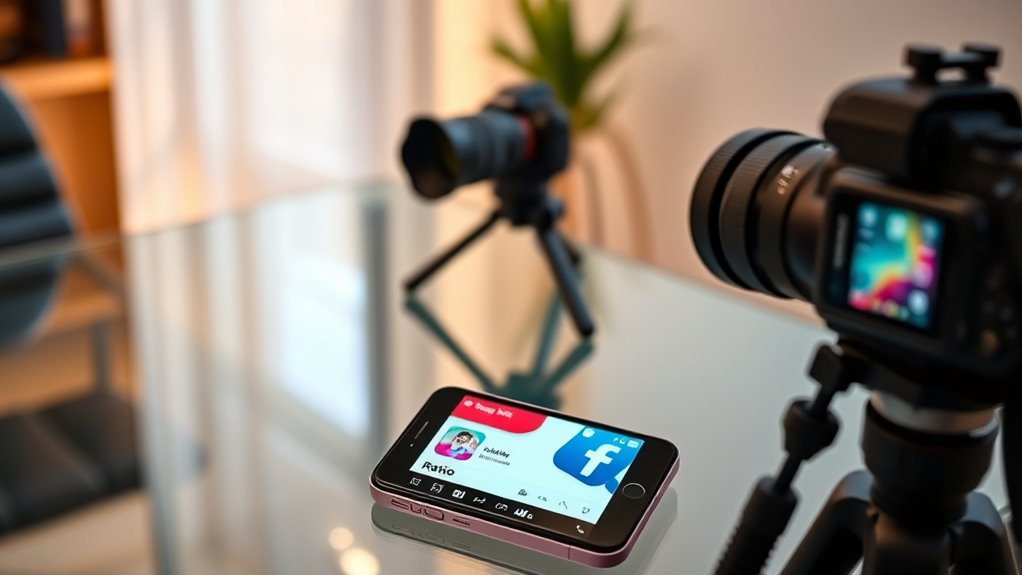
Ratios help you gauge how your content resonates with your audience by analyzing engagement metrics. They also reveal how well you balance your content and reactions, shaping your online presence. Additionally, ratios serve as key indicators of an influencer’s impact, influencing perceptions and interactions. Understanding tuning modifications can further optimize your digital strategies for better results.
Interpreting Engagement Metrics
Understanding engagement metrics is essential for making sense of online interactions, as these numbers reveal how audiences respond to content. When analyzing ratios like likes to comments or shares, you can assess the true impact of viral trends and content virality. A high ratio often indicates strong audience resonance, while a low ratio might suggest superficial engagement. To interpret these metrics effectively, consider:
- The context of the content’s reach and audience size
- How engagement ratios relate to specific platform norms
- Whether spikes in ratios align with viral trends or shifting audience interests
Additionally, research supports the use of tools like 16PF for predicting engagement patterns, helping creators better tailor their content strategies.
Balancing Content and Reactions
While engagement metrics shed light on audience reactions, maintaining a balance between content quality and reactions is vital for meaningful digital discourse. Viral trends often influence content algorithms, shaping what gets promoted or overlooked. If your content sparks more negative reactions than positive, it signals an imbalance that can harm your online presence. To navigate this, consider how reactions reflect your audience’s true interests versus fleeting viral trends. Focus on creating authentic content while monitoring ratios to guarantee your message stays clear and impactful. Recognizing the importance of social media influence can help you better understand how platforms shape digital discourse and audience perceptions.
Influencer Impact Indicators
Influencers’ impact on digital discourse is often gauged through specific indicators, with ratios playing a crucial role. These ratios help you understand how content resonates, especially in viral trends and meme culture. High ratios, like a large number of likes or retweets relative to comments, signal positive engagement and influence. Conversely, a low ratio may indicate controversy or decline in relevance. Here are key influencer impact indicators:
- Engagement Rate: Measures how actively audiences interact with content, highlighting viral potential.
- Comment-to-Like Ratio: Reveals audience sentiment—more comments can mean stronger opinions or debates.
- Share-to-View Ratio: Indicates how much content fuels meme culture and spreads across platforms quickly.
- Integration with Email Marketing Tools allows for targeted follow-up campaigns based on engagement ratios, enhancing overall marketing effectiveness.
Tracking these ratios helps you grasp an influencer’s true influence in shaping online discourse.
Tips for Navigating and Responding to Ratios

Ever wondered how to handle a social media ratio that doesn’t quite add up? When you encounter a low ratio, it’s often linked to viral trends or algorithm influence that skew engagement. To navigate this, stay calm and analyze the context—viral content can inflate likes or comments temporarily. Respond thoughtfully by engaging with your audience without overreacting; this shows authenticity. If the ratio signals negativity or controversy, consider addressing concerns directly or clarifying your intent. Remember, ratios are influenced by factors beyond your control, like algorithm changes or trending topics. Focus on creating genuine content and building meaningful connections rather than obsessing over immediate metrics. By understanding how viral trends and algorithm influence ratios, you can respond more effectively and maintain your online presence. Recognizing the impact of algorithms on engagement can help you interpret ratios more accurately.
Frequently Asked Questions
Can Ratios Predict Future Online Trends or Behaviors?
Ratios can help predict future online trends or behaviors by analyzing viral metrics and engagement indicators. When you observe high ratios, it suggests strong user interest or content resonance, which may signal upcoming popularity. By monitoring these ratios, you can identify patterns and anticipate shifts in online activity. Keep an eye on engagement indicators like likes, shares, and comments to better understand potential future trends and tailor your content strategy accordingly.
How Do Cultural Differences Influence Ratio Interpretations?
Cultural differences considerably influence how you interpret ratios online, as cultural perceptions shape your understanding of data. You might see a high ratio as positive in one culture but negative in another, due to interpretation biases rooted in cultural norms. These biases can lead to misjudging online trends or behaviors. Recognizing these differences helps you avoid misinterpretations and develop a more accurate, culturally aware perspective when analyzing ratios across diverse online communities.
Are Ratios More Significant on Specific Social Media Platforms?
Ratios act like a thermometer for social media buzz, revealing how well your content resonates. On platforms like Twitter and TikTok, they often carry more weight because viral metrics and engagement indicators are crucial for visibility. You’ll find ratios especially significant when evaluating how your posts perform compared to others, helping you gauge if your message hits the mark or needs adjustment to boost your online influence.
Do Ratios Affect a User’s or Brand’s Long-Term Reputation?
Yes, ratios can impact your long-term reputation by influencing audience engagement and brand perception. When your content receives a favorable ratio, like more likes or positive comments, it shows your audience values your message. Conversely, a poor ratio can signal disinterest or controversy, potentially damaging your brand’s image. Over time, consistent ratios shape how people see you or your brand, affecting trust and credibility.
How Can Creators Leverage Ratios to Improve Engagement?
You can leverage ratios by analyzing engagement metrics and conducting audience analysis to identify what resonates most. Don’t overlook small ratios; they reveal valuable insights. Use this data to craft content that sparks interactions, encourages sharing, and builds community. By understanding your audience’s preferences and adjusting your strategy accordingly, you boost engagement, foster loyalty, and create a more active, involved follower base that supports your growth.
Conclusion
Understanding ratios helps you gauge how people really feel about your posts. Some might think they’re just numbers, but they reflect public opinion and can shape your online reputation. Don’t worry if a high ratio feels intimidating—view it as a chance to learn and improve. By paying attention to ratios, you can navigate digital conversations smarter. Embrace them as tools for growth, not obstacles, and keep engaging authentically online.
